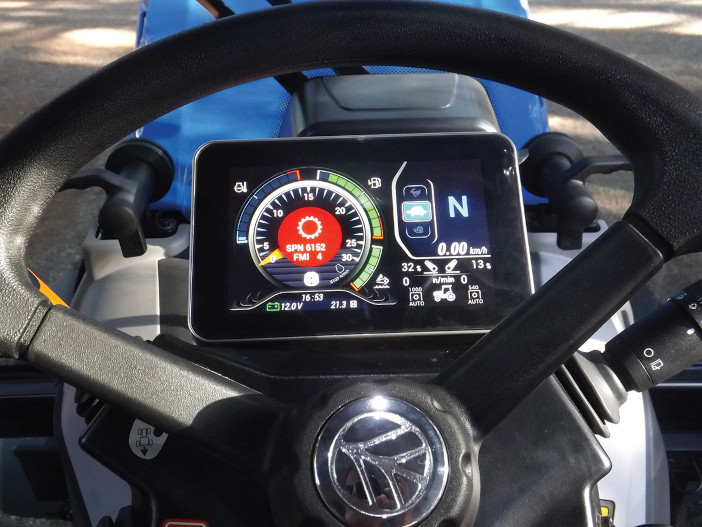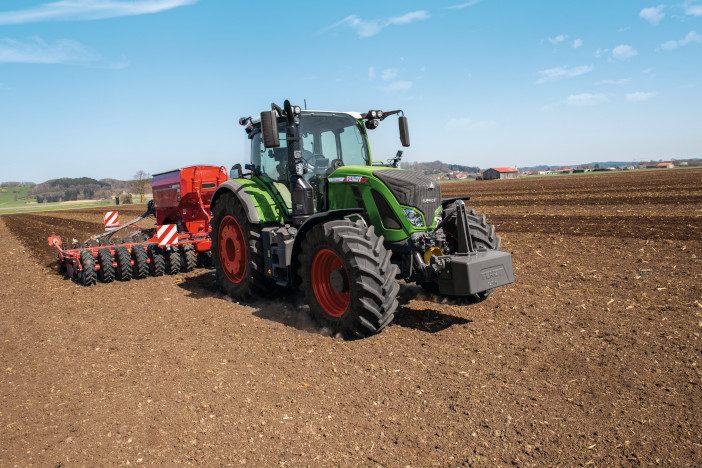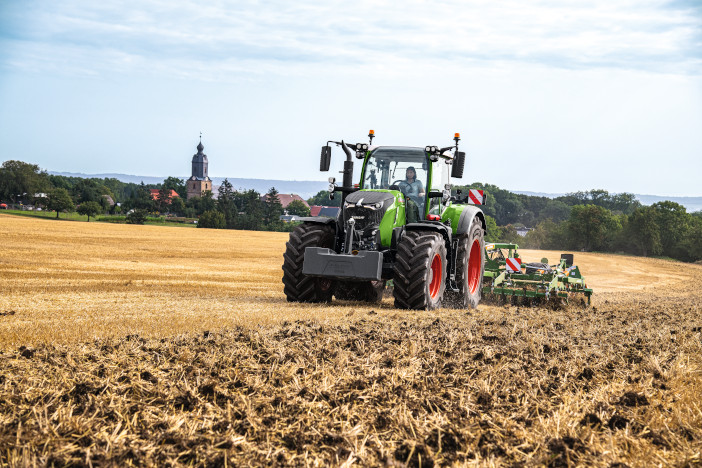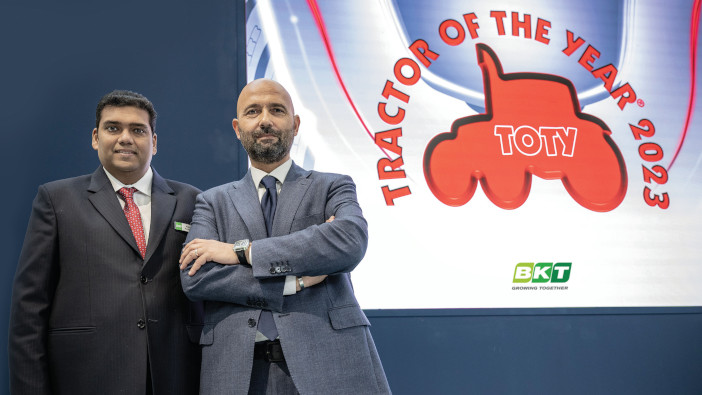After months of in-field tests, the industry came together at EIMA to see the Tractor of the Year awards handed out.
As the UK judge, Farm Contractor & Large Scale Farmer has joined the other 24 European jury members to travel across Europe, and even to Turkey, to put each of the finalist tractors to the test.
The award is sponsored by BKT, which has supported the process from the Let the Challenge Begin event back in June, where the jury members shortlisted the finalists, through to the lavish ceremony at EIMA.
A total of 16 tractors, from 13 manufacturers, entered the competition, split across four categories:
- Best of Specialized – orchard, vineyard, hill and mountain tractors
- Best of Utility – multi-purpose and utility tractors between 70hp and 150hp, with four-cylinder engines and a maximum operating weight of 10,500kg
- Tractor of the Year – open field, broad acre category
- Sustainable TOTY – all entrants are added to this category, which looks at comfort, safety, efficiency and connectivity.
“We cannot but be proud of supporting this award directed towards the future of agriculture,” said Lucia Salmaso, CEO of BKT Europe. “Innovation, technology, and the stimulus of doing always more and better with a sustainable viewpoint are actually true motors that drive BKT, pushing us to produce tires of always improved features that are perfect for every situation.
“It amazes me every year when I see the unbelievable solutions developed in terms of technology and for the manufacturers’ in-depth studies.”
Over the next three pages, we will look at each of the winners in detail, highlighting the areas that the jury singled out as particularly innovative and important.

SUSTAINABLE TOTY – JCB Fastrac 4220 iCON
JCB took away the Sustainable TOTY award due to the significant increase in precision farming systems compared to the previous generation. A new electronic infrastructure, culminating in a significantly updated terminal and armrest enables users to customise nearly all functions across the tractor and save profiles to suit different users and operations.
The various steering modes, including four-wheel steer and crab steer, mean that the machine is gentle on the soil and surprisingly agile considering its size. Its capabilities in row crops can be boosted with the innovative TwinSteer autosteering system – in which both the front and rear axles are controlled independently through two GPS receivers.
Fully integrated is JCB’s LiveLink telematics system, enabling real-time data transfer and proactive maintenance from the service team. One of the most impressive parts of the tour of JCB’s facilities was seeing the setup, in which all LiveLink-connected machines are monitored, with a traffic light system to see minor and major failures.
The jury found that the combination of hardware and software made the tractor more efficient, safer, more comfortable, more connected, and more reliable and it positively affects the total cost of ownership and consumption costs.
Testing it both on the road and in the field, we were particularly impressed with the ease of use and intuitive control layout. The driving logic can be completely overhauled to suit the operator’s preference, and the proven JCB suspension system meant that it was very comfortable – even when travelling at the top speed of 60kph.
Greg Fitton, general manager of Fastrac sales, accepted the award alongside John Smith, managing director of JCB Agriculture, and said: “It’s a wonderful surprise to receive this award. The Fastrac iCON is not a typical tractor and this is a testament to the hard work of our engineering team.”

BEST OF SPECIALIZED – New Holland T4.120 F
Offering a huge amount of precision technology in a compact package, the New Holland T4.120 F took away the Best of Specialized award.
The specialised market is a complex one. Requiring the smallest possible tractors but, due to the high-value crops being grown, also requires similar precision farming systems that we see in the high horsepower segment. This presents a quandary that manufacturers have been trying to overcome.
Emission regulations have made this more complex, as seen in the New Holland T4.120 F, where the requirement to meet Stage V was complicated by customer demands to lower the bonnet to improve visibility. The winning model has achieved a hood height of 96cm, just 1cm higher than the 2006 Stage IIIA model and 4cm lower than the 2014 Stage IIIB model. This is achieved by the development of a new FPT ultra-compact 118hp engine, 20cm lower than the standard version enabling the fitment of a DOC and SCRoF system while retaining high visibility.
The tractor can reach speeds of 40kph through its 44×16 manual transmission, with an electro-hydraulic power shuttle and a HiLo splitter. Around the compact design, New Holland has managed to integrate an 80 litres per minute hydraulic system, which prioritises the rear hitch before sending oil to the remotes. There is also a dedicated 36-litre steering pump.
Up to four rear remotes can be fitted at the rear, with eight dedicated couplers, with the option of Power Beyond. An additional eight mid-mount couplers can be specified and in the cabin, there is a dedicated electronic joystick available to control hydraulic functions.

Despite the size of the tractor, the VisionView cab was spacious, and the company has retained a flat deck. Because of the design of the windscreen, the narrow roof and the low bonnet, visibility has been significantly increased. It’s also quiet, with a reduction in noise levels from the previous generation from 77dBA to 71dBA. A digital dashboard has been fitted, enabling the operator to adjust the hydraulic flow, as well as set up delayed hydraulic functions.
Continuing to adopt systems from the higher horsepower range, New Holland can offer the machine with the Terraglide suspension system. Beyond this, there are two other axle options. The SuperSteer system increases the turning angle from 55 degrees to 76 degrees, while the low-profile option lowers the overall height.
Perhaps the most impressive side of the T4.120 F was the availability of precision farming systems. Customers can choose an AutoGuidance system, with the IntelliView IV display linked with a GPS receiver and the EZ-Pilot steering valve. This can be further linked to ISOBUS for variable rate applications and implement control, and New Hollands MYPLM Connect telematics system.
The jury highlighted that many of the standout features were brought down from the larger machines in the New Holland range. The fact that it is available with a suspended front axle, combined with the updated cabin provided best-in-class comfort, while the availability of advanced guidance systems has pushed the specialist class forward.
Sean Lennon, vice president of sales, Europe, said: “We really appreciate the award. It’s a credit to the engineering team and we would like to thank the jury for voting for us.”

BEST OF UTILITY – McCormick X6.414 P6-Drive
Recognising the need for increased versatility from lower horsepower machines, the McCormick X6.414 P6-Drive is a worthy winner of the Best of Utility award
Rapidly becoming a mainstay in the Tractor of the Year competition, McCormick’s Best of Utility entry impressed the jury with the level of in-house development and the machine’s capabilities in the field, despite the compact size.
The winning machine offers 135hp, boosting to 146hp, from an FPT engine with torque levels of 551Nm available at 1,400rpm. One of the standout features was the newly developed, in-house P6-Drive gearbox. It’s a powershift system with six gears and four ranges for a total of 24×24, increasing to 40×40 when a creeper box is fitted. Importantly, there is a total of 16 gears between the main working speeds of 4kph and 12kph, with a Smart Auto Power Shift function to operate the gearbox like a continuously variable transmission.
A closed-centre, load-sensing hydraulic system offers 114 litres per minute, with a 44-litre pump dedicated to a low-pressure circuit and lubrication. Up to five rear spool valves can be specified, and controlled electronically, with the option of two electronic mid-mounts and Power Beyond functionality. The rear hitch can carry up to 7,200kg, while the optional front linkage has a capacity of 2,500kg.
For operator comfort, a self-levelling front suspension is available with electro-hydraulic engagement of the differential lock and four-wheel drive fully integrated. There is also a mechanical cab suspension, using rear shock absorbers with 96mm stroke to dampen undulations.
Given the size of the tractor, the X6.414 P6-Drive has been optimised for loader work, with the fitment of a high-vision cab enabling operators to see the loader attachment without straining. Controls have been laid ergonomically on the armrest, including the All-in-One joystick offering engine, transmission and hydraulic controls, while tractor functions can be fully adjusted through the Data Screen Manager terminal, which is a touchscreen system with smartphone functionality.
Jumping in the tractor, we felt that it offered a high level of comfort and precision while remaining intuitive. The terminal features a one-button return to the main menu, with a pictorial display to easily guide operators through the various functions.

The options list includes a wide variety of precision farming systems and telematics. It’s ISOBUS compatible and can be specified with a full range of Topcon guidance, variable rate and section control functions. The X6 is also linked to McCormick’s own telematics system, which enables the owner to set up a geofence, as well as wirelessly send tractor data and positioning to the office and proactively warn of upcoming maintenance.
During the voting process, the jury highlighted not only the new transmission but also the high-quality cabin, which used automotive design principles to create a comfortable environment for long working days. It was also clear that the company had adopted technologies recognisable from the open field category to increase the versatility and productivity of a utility tractor.
Upon collecting the award, marketing manager for Argo Tractors, Antonio Salvaterra, said: “It is always a real pleasure to participate in the Tractor of the Year competition and winning this award is a fulfilment of the work and effort that has gone into the development of this tractor.”

TRACTOR OF THE YEAR – Fendt 728 Vario
A completely new intelligent driveline was the headline of the latest generation of Fendt 700 Vario, which won the Open Field category at Tractor of the Year.
The 700 Vario has always been an important range for Fendt, being its best-selling range of tractor, and with each new generation following the customer demand for more horsepower in a relatively compact package.
The seventh generation, launched early this year, includes a completely new driveline, adapted from the VarioDrive system first launched on the 1000 Vario. The 728 Vario is powered by an all-new AGCO Power six-cylinder engine, offering 283hp and increasing to 303hp with the DynamicPerformance system. Unlike a traditional boost system, DynamicPerformance is not tied to any parameters of the operation, instead, it delivers power when the machine recognises the additional need for it – for example, when stationary but operating a PTO-powered implement.
The VarioDrive continuously variable transmission also works dynamically, powering independent hydrostats on each axle. This means that all-wheel drive is available automatically and at all times, but during transport, the second hydrostat will decouple to reduce fuel consumption.
This links to the Fendt iD concept, which sees key driveline components optimised to reduce the engine speed. The overall rated engine speed is just 1,700rpm; the main working range is between 1,400rpm and 1,700rpm, and the tractor can reach 50kph at 1,200rpm and 40kph at 950rpm.
Also brought down from the 1000 Vario is the Concentric Air System ventilation and cooling functions, which is driven by its own hydraulic motor (therefore decoupled from the engine speed) and works on demand. The compact cooling package is also designed in such a way as to reduce the fan speed and require around 40% less drive power.

Hydraulics power comes from a modular system, offering 220 litres per minute for a maximum of five connections at the rear, two at the front and three mid-mounts. To limit the risk of leakages, Fendt uses flat-face couplers.
The cabin layout will be familiar to those who have experience with the brand. Tractor and implement functions are controlled via the multi-function joystick and there is an optional 3L joystick to handle additional features, with three layers of customisable controls.
It also features the FendtONE system, which wirelessly links the tractor to the farm office, with a similar layout both on the computer and on the terminal and the possibility to fit three different screens in the cabin to have all relevant functions in eyesight – this includes the ten-inch digital dashboard, the 12-inch standard terminal on the armrest and an additional 12-inch terminal mounted in the right hand side of the roof.
Fendt’s full range of precision farming systems is available, including section control and variable right. It can also be specified with Contour Assistant, automatic headland management, Turn Assistant and Fendt Connect telematics. A fully integrated VarioGrip tyre inflation system is also available.
The sheer number of in-house developments was highlighted by the jury as the reason for Fendt taking the prize. It was the driveline which works with the Fendt iD system to further reduce power requirements and fuel consumption that particularly grabbed their attention.
Independent control of the front and rear axles provides a pull-in effect when steering, significantly reducing the turning circle of the machine, which with its 30.5kg per hp power-to-weight ratio, makes the 700 Vario an agile, surprisingly compact machine.


